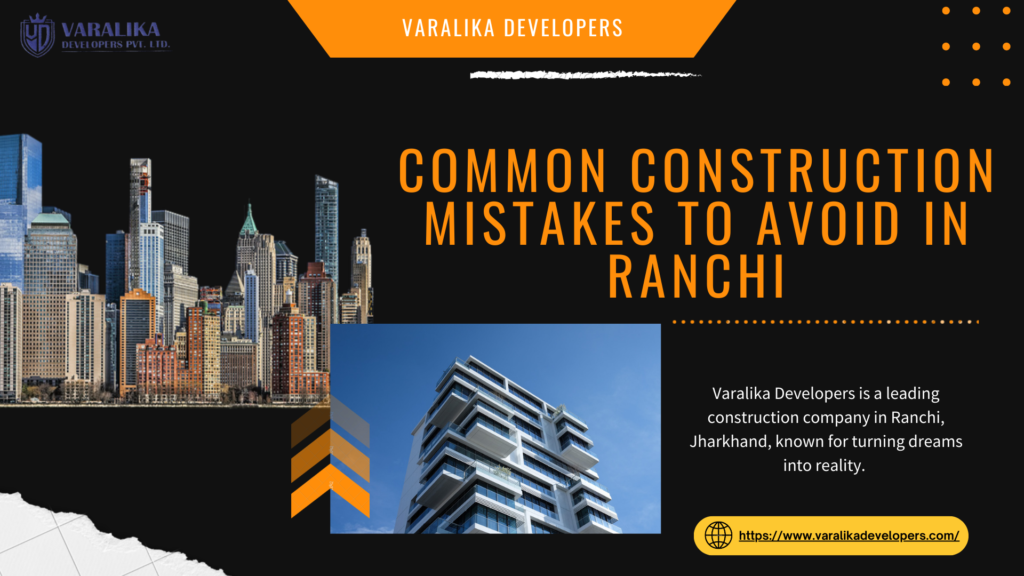The city of Ranchi, with its growing urban landscape and diverse climate, presents unique challenges for builders and developers. Whether constructing residential homes, commercial buildings, or public infrastructure, the combination of weather conditions, terrain, and local regulations can make construction projects complex. While the opportunities for growth are abundant, there are several common construction mistakes that can delay progress, increase costs, or compromise the quality and longevity of buildings. In this article, we explore these common pitfalls and provide insights on how to avoid them when building in Ranchi.
1. Ignoring the Local Climate in Design and Material Selection
One of the most frequent mistakes in construction projects in Ranchi is failing to account for the local climate when designing buildings or selecting materials. Ranchi experiences a subtropical climate with hot summers, a heavy monsoon season, and mild winters. Ignoring these factors can lead to structural issues, increased maintenance costs, and discomfort for occupants.
Mistake: Using inappropriate materials that cannot withstand Ranchi’s weather extremes can result in long-term damage. For instance, materials that absorb too much heat or fail to resist heavy rain during the monsoon may degrade quickly.
Solution: Builders should choose materials that are suitable for the climate. Brick, stone, and cement are often better suit to the hot and humid conditions than materials like wood, which can warp and deteriorate under heavy rainfall. Additionally, climate-responsive architecture—such as large windows for natural ventilation, sloped roofs for monsoon rains, and sunshades for heat—can make a significant difference in building longevity and comfort.
2. Inadequate Site Preparation and Soil Testing
Before any construction can begin, it’s crucial to assess the building site properly. One of the biggest mistakes in Ranchi is not conducting thorough soil testing and site preparation. Ranchi’s terrain is varied, with rocky areas, forested land, and uneven topography, which can all affect the structural stability of a building.
Mistake: Skipping detailed soil testing or site surveys can result in unstable foundations, waterlogging, or even structural failure. Many builders make the mistake of assuming the land is suitable for building without conducting proper tests.
Solution: Conducting a detailed geotechnical survey is essential before beginning construction. Soil testing helps determine the soil’s load-bearing capacity, moisture content, and composition. This ensures that the foundation is built to with the soil’s characteristics. If the soil is weak or unstable, reinforcement techniques such as piling or soil compaction. May be necessary to prevent future problems like sinking or shifting foundations.
Additionally, during the site preparation stage, grading the land to ensure proper drainage is critical, particularly in a city like Ranchi that experiences heavy monsoon rains.
3. Poor Water Management and Drainage Systems
Water management is a key concern in Ranchi due to the heavy monsoons that can last for several months. One of the most common construction mistakes is failing to design adequate drainage systems, which can lead to waterlogging, flooding, and erosion around the building site.
Mistake: Builders often underestimate the impact of heavy rains, which can lead to water pooling around the foundation, damaging the structure, and even causing flooding inside the building.
Solution: Designing efficient drainage systems, both on-site and in the building itself, is essential. This includes incorporating sloped surfaces, underground drainage pipes, rainwater harvesting systems, and sump pumps where necessary. Gutters and downspouts should be properly install to direct water away from the foundation. Additionally, installing porous paving materials can help absorb excess rainwater and prevent water accumulation on roads and driveways.
During the monsoon, drainage systems are tested to their limits, so it’s vital to ensure they are built to handle the volume of water Ranchi typically receives.
4. Overlooking Earthquake-Resistant Designs
Jharkhand, including Ranchi, is situate in an earthquake-prone zone (Zone III as per the seismic zoning map of India). This makes earthquake-resistant design a critical consideration when constructing buildings in Ranchi. However, many builders neglect this aspect, particularly in smaller residential projects, which can lead to significant safety risks.
Mistake: Not incorporating seismic design principles in construction projects can lead to structural failure during an earthquake, putting lives and property at risk.
Solution: Following earthquake-resistant construction techniques is crucial. This involves reinforcing structures with steel bars, using shear walls. Cross-bracing, and ensuring flexible foundations that can absorb and dissipate seismic energy. Modern buildings should comply with the latest seismic codes and regulations, ensuring that they are capable of withstanding earthquakes. Builders should also conduct regular inspections during construction to ensure that all seismic standards are being adhered to.
For multi-story buildings, additional measures such as the use of lightweight materials and proper distribution of load are necessary to prevent collapse during an earthquake.
5. Failing to Adhere to Local Building Regulations and Codes
Each city has its own set of regulations and codes governing construction activities, and Ranchi is no different. Failing to comply with local laws and guidelines can result in project delays, fines, or even the demolition of buildings deemed non-compliant.
Mistake: Many builders make the mistake of starting construction without proper permits or not following the specified guidelines for safety, zoning, and land use. Non-compliance can lead to legal issues, as well as additional costs for rework or fines.
Solution: Before beginning any project, it’s essential to obtain all necessary permits and approvals from local authorities. Including land use clearance, environmental clearances, and zoning approvals. Familiarize yourself with the Ranchi Municipal Corporation (RMC) rules regarding setbacks, floor-area ratios, building heights, and usage of land. Adhering to these regulations not only avoids legal trouble but also ensures the safety and integrity of the structure.
Moreover, it’s important to ensure that the project meets fire safety, electrical, and plumbing standards. Conducting regular inspections and audits during construction will help ensure that all safety codes are being follow, preventing potential hazards down the line.
6. Skimping on Quality Control and Supervision
Another common mistake made during construction in Ranchi is the lack of adequate supervision and quality control. This is often seen in large-scale projects or when unskill labor is used without proper oversight. Poor quality control can lead to subpar workmanship, which can affect the overall safety and longevity of the building.
Mistake: Builders sometimes cut corners by using low-quality materials, or fail to properly supervise workers, leading to construction defects like cracks, leaks, or structural instability.
Solution: Ensuring high-quality materials are used and closely monitoring construction processes is key to avoiding defects. Regular site inspections should be carried out by qualify engineers or supervisors to ensure that the construction is progressing according to plan and that the materials used meet industry standards.
Concrete mix, reinforcement placement, plumbing, and electrical installations should all be carefully checked for compliance with design specifications. It’s essential to hire skilled labor for specialized tasks like wiring, plumbing, and finishing, to avoid costly repairs or rework in the future.
Implementing a quality control plan, which includes periodic testing of materials and on-site inspections, can help maintain the desired standard of construction and avoid future complications.
7. Rushing the Curing Process of Concrete
Concrete is one of the most widely used materials in construction, and proper curing is essential to achieving the desire strength and durability. However, one common mistake made in construction projects in Ranchi is rushing the curing process to save time, which compromises the structural integrity of the building.
Mistake: Builders often remove formwork too early or do not allow enough time for the concrete to cure properly, leading to weak structures that are prone to cracking or even collapse.
Solution: Proper curing is essential to ensure that the concrete achieves its full strength. The curing process requires maintaining adequate moisture and temperature levels for a specific period, typically around 7 to 28 days, depending on the structure and the weather conditions.
In Ranchi’s hot climate, it is especially important to ensure that concrete surfaces do not dry out too quickly. Keeping the concrete moist by spraying it with water, covering it with wet burlap, or using curing compounds can prevent rapid drying, which can cause cracks. Builders must ensure that the curing process is given adequate time and not rush through it to meet tight deadlines.
Note: Click to know about Construction Company in Ranchi
Conclusion
Construction projects in Ranchi come with their own set of challenges, many of which can be avoided with proper planning, adherence to local regulations, and a focus on quality control. By taking the local climate into account, conducting thorough site assessments. Implementing sustainable design practices, builders can ensure that their projects are durable, safe, and well-suited to the region’s environmental conditions. Avoiding these common mistakes can not only save time and money but also result in better, longer-lasting structures that contribute to the city’s growth and development.



More Stories
PVD-Coated vs. Traditional Furniture: Who win?
PCD Pharma Franchise Company in Baddi: Oasis Bio Bloom
Brass Hose Fittings: Perfect for Any Industry